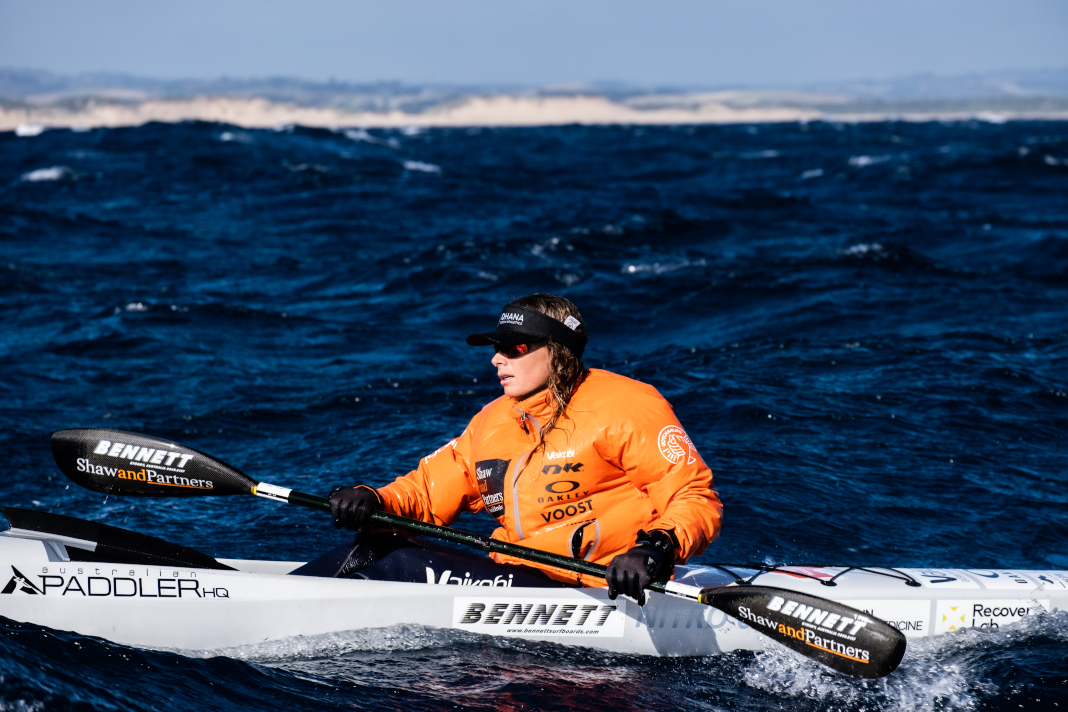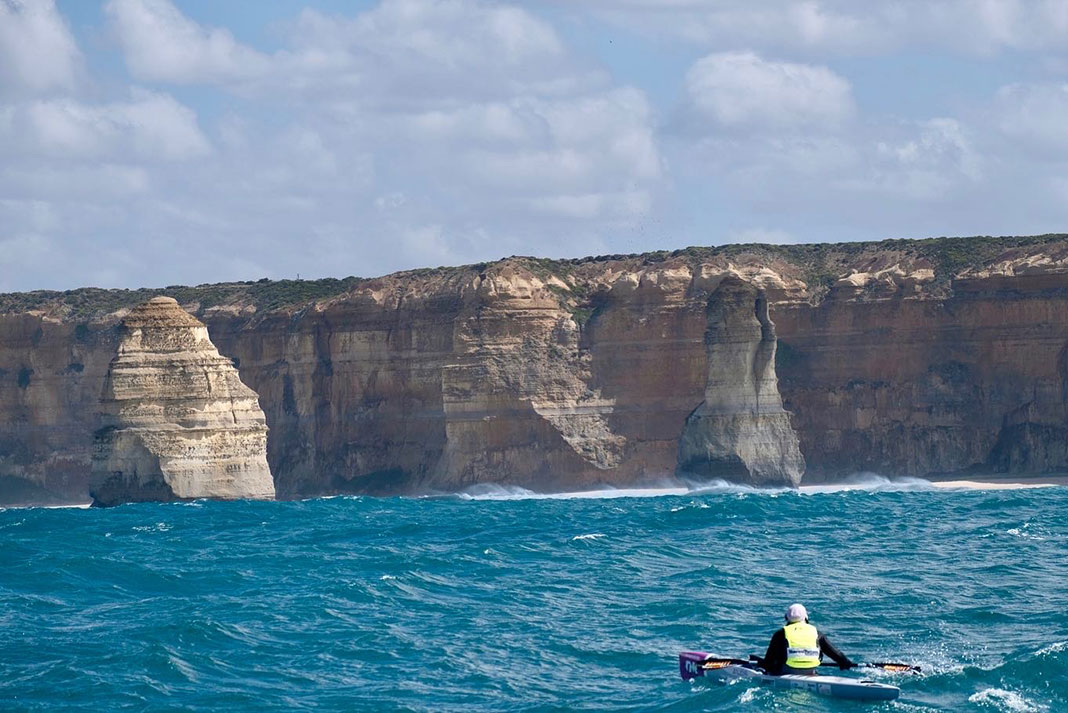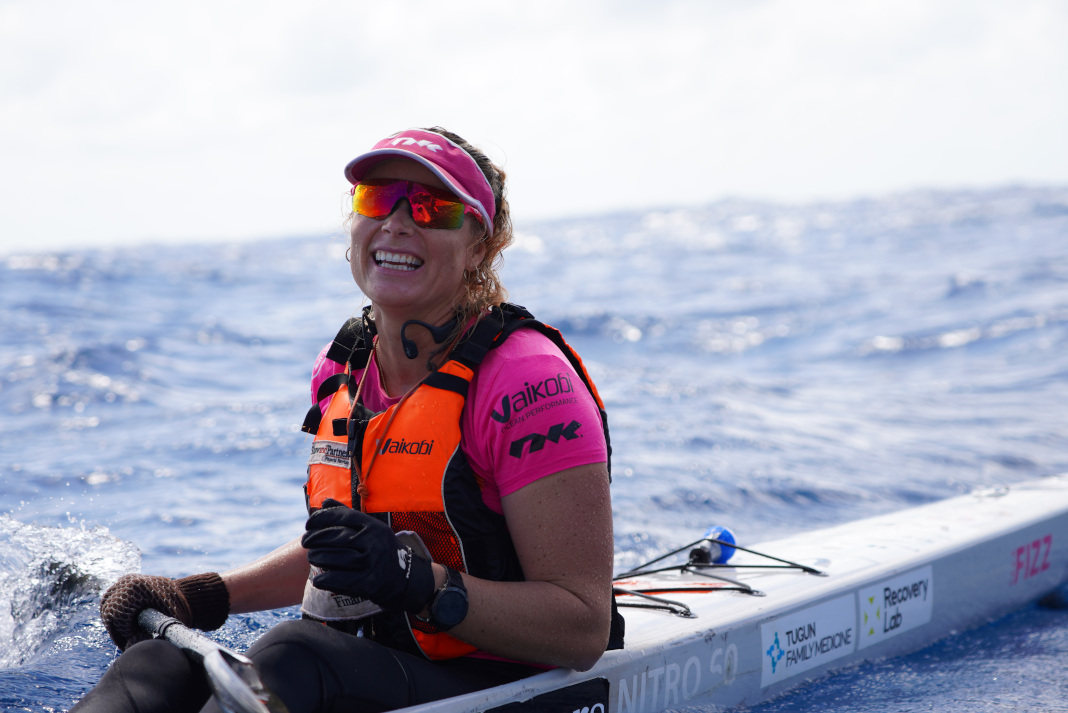Products You May Like
Bonnie Hancock became the fastest person to paddle around Australia on August 28, 2022.
Hancock set out on December 19, 2021 with the goal of circumnavigating her home country by surfski. 254 days later, she landed back at her starting point, having covered 12,700 kilometers of Australian coastline in record time. Inspired by Freya Hoffmeister, who still holds the speed record for an unsupported paddle around Australia in 2009, Hancock paddled through massive ocean swell, debilitating seasickness, sharks and crocodiles. Hancock used the journey as an opportunity to fundraise for Gotcha 4 Life, a mental health charity in Australia.
Paddling Magazine contributor Brooke Hess had the opportunity to sit down with Hancock and discuss her incredible expedition.

Paddling Magazine: Where did you come up with the idea to circumnavigate Australia by surfski?
Bonnie Hancock: Three years ago, I read a book by Joe Glickman called Fearless, about Freya Hoffmeister. She is a German woman who paddled around Australia in 2009. As soon as I read it, I could not get the idea out of my head. There was something about the adventure part of it that just sparked this inspiration in me. For six months I tossed the idea around. There were so many reasons not to do it—financially, career-wise (at the time I was working full-time as a dietician) and just the time it would take. But after six months, I couldn’t let the idea go.
PM: Can you tell us more about Gotcha 4 Life and how you got involved with them?
Hancock: I first heard of Gotcha 4 Life through the Shaw and Partners ocean racing series. We did a race over here that was raising money for Gotcha 4 Life.
Through COVID, I’d seen friends really struggle with job losses and relationship breakdowns. Anxiety and depression were at an all-time high and the statistics were showing that. I was thinking I really wanted to do something good with this project, and I thought there is no better time or no better cause than what I used to call “mental health.” Now, Gotcha 4 Life has taught me to call it “mental fitness” because they look at it as something you work on just like your physical fitness. It’s something you constantly need to work on.
Gotcha 4 Life implements programs from school age through corporate workplaces. They believe everyone should prioritize mental health because if it’s not affecting yourself, it’s affecting someone close to you. One in five people are currently affected by poor mental fitness.
They have a really clear mission to achieve zero suicides. And to do that, we need to break the stigma behind being able to speak about our mental fitness. That really drove me the whole way.
PM: It took you 254 days. The logistics must have been insane. How did you go about organizing this?
Hancock: I had a crew—there were two on the boat and two on land, so five including me. We had to feed our team of five plus we had to find a support vessel… It ended up being a lot more expensive than I ever imagined. Food, accommodation, and the other one is fuel for the boat.
We basically had to not only feed a whole crew the whole time but also find accommodation, during COVID in Australia. Different parts of the country were affected really badly and other parts were okay. Western Australia was very strict with rules at the time. They weren’t letting anyone into the state. I was really worried that I would get halfway around and be stopped. Fortunately they gave us an exemption to cross into the border.
There were times we didn’t see our land crew for three weeks at a time. There was no reception at sea, so logistically it was really, really tough.
PM: How did you train for this?
Hancock: That’s such a good question because I asked myself the same one. How do you train for 100-kilometer days, back to back?
And the answer is: you can’t.
I kept the same training that I’d normally do for surf lifesaving or for the ocean ski. I trained with my surf club, I did no more than 10- to 20-kilometer paddles. I did a lot of gym work to strengthen my core.
The first six months [of the circumnavigation], it was all about conditioning. My back was in agony as it struggled to adjust.
I knew there would be an adjustment period, and I thought that if I can just hold on and let the body condition, it’ll get easier. There were times I wanted to quit in that first six months, but I thought that one day it would click in.
All of a sudden around six weeks, I had a day where I wasn’t sore! And from there I got stronger and stronger. But it was a high injury risk at the start because you’re just pushing your body to do what it’s never done before.

PM: What was your diet like while paddling? How many calories were you consuming each day?
Hancock: We had plenty of healthy foods at dinners. We did a lot of veggies, a lot of good quality meats, but I also had my body science supplements in there. I was doing amino acids and protein shakes throughout the day, desperately trying to refuel my body what it was losing.
I would randomly hit low blood sugars at certain times, even though I’d eaten a really good amount of high-quality carbohydrates. Your body just does all sorts of weird things, so I would always have some chopped fruit ready to go.
When you paddle those 100-kilometer-plus days, and you’re spending 12 to 14 hours on the water, you start to crave all sorts of funny things. I would crave things like burgers, cupcakes, chocolate… I actually gave into the cravings and I sort of let myself enjoy some of those treats, even when it didn’t make sense.
PM: Can you share a story of the lowest point of your paddle? What was your least favorite part?
Hancock: That’s such a good question because there’s a few of them that come to mind. Crossing the Great Australian Bight was in a way traumatizing, to be honest.
We were 500 kilometers out at sea on a tiny little ocean ski. The water’s black out there. It is three kilometers deep. So you look around, you are in black water, you know how big the creatures can get out there… great whites, huge whales.
You’re essentially surfing the most amazing runners of your life, but also quite scared all the time, and I got really seasick. The [support] boat can’t anchor out there, so when I would stop paddling at the end of the day, the boat would bob around. I was vomiting pretty much the entire time. I kept no food down, sometimes three days at a time. We would celebrate when I did hold something down.
I lost eight kilos in two weeks, which is interesting because I had put fifteen kilos on before this paddle. I lost eight of that across the Bight, and I had already lost around five. By the time I crossed the Bight, I was malnourished, fatigued and had to get IV fluids pumped into me. I could barely walk when I came to the hospital. When I was at my lowest in the Bight, they were spoon-feeding me. Ice cream was the only thing that would stay down, and my crew actually had to make the chewing movements with my mouth because I couldn’t even chew at that stage. And then I had to get in the water and paddle a hundred kilometers. So it’s amazing what the mind can do when you physically should not be able to paddle a hundred kilometers.
PM: Sufferfest for sure. In contrast, can you tell us about your favorite part?
Hancock: Western Australia really stands out. It’s a beautiful part of the country and Ningaloo Reef is over there. We called it the “Pirates of the Caribbean Day” because the blue of the water was absolutely incredible, and the white sand—it was literally like being in a postcard paddling along this reef.
I saw 25 big turtles in one day, there were dolphins, and we’d been through the Bight, we’d been through all that trauma, we’d gotten to Western Australia, we’d gotten through the [COVID] exemption and been let in, and it was just a celebration. The conditions were perfect. It was flat with some tailwinds some days.
If anyone internationally or within Australia gets a chance, Ningaloo Reef in Western Australia [is] a spot you’ll never, ever forget. I’ve never seen a coastline like it before in my life. I’ll keep trying to find coastline like that throughout the world, but I think it’s very, very rare.
PM: Were there other fascinating encounters from the trip?
Hancock: I actually have a crocodile story for you.
I did a lot of night paddling to get the kilometers in. So, I figured out that I needed to paddle 14 hours a day, but if you only get 11 hours of sun in the day you’re doing night paddling. But with the big tides, you go two kilometers an hour against the tide and around 18 kilometers per hour with the tide. So, I would paddle six hours on, six hours off, six hours on, to get those tides with me. So that meant paddling in the middle of the night in crocodile-infested water.
One night it was pitch black, midnight, and it was quiet. You could hear every splash in the water.
I was paddling behind the boat, and they would do spot checks—they had the torches out to the side, looking for the crocodiles. And the boat got stuck in an eddy off an island. So I’m following the boat around this whirlpool, like, “What are we doing?” And all of a sudden, my coach on the boat said, “Come up. Come up to the boat.”
I was like, “Yeah, yeah, I’m coming… like, I’m so fatigued. I’m coming.”
He goes, “No, right now. You might want to stick close to the boat.”
And I said, “Okay.”
So I paddled up to the boat and they all looked quite worried, but they didn’t say anything. The boat was able to break the current and we were able to keep going, but I noticed they kept the pace really high.
It was a week later that they told me that when they shined the torches out to the side, they had seen the silver of the crocodile’s back. It was 10 meters away from me, waiting outside the current for me.
PM: In addition to your record-breaking circumnavigation of Australia, you also just broke the male world record for farthest distance paddled on the ocean in 24 hours, correct?
Hancock: Yeah, so I managed to get the women’s record throughout the [Australia circumnavigation] paddle when I did 213 kilometers in 24 hours. I then found out that the men’s record was 227 kilometers and it was set by Quinton Ruthford from South Africa in 2020. I decided that my body is never ever going to be conditioned like this in my life ever again—it’s taken eight months to get to this point. I may as well give this a crack!
I just love watching people push the bar higher and higher. It was never about beating the boys or anything like that. I wanted to show what women can do, but also just what humans can do as well. But it was super tough.
I did it this week over Monday and Tuesday, so I’m still blistering around the face because I couldn’t even put sunscreen on. I was so on the hammer to get that record. I had to do the last hundred kilometers pretty much at threshold. I had to hold 10 kilometers an hour.
I managed to get 234 kilometers. It’s unofficial still. You have to submit all of your evidence to Guinness World Records, but I did manage to get that distance and am so excited. I’ve received some really lovely messages from Quinton of support as well. When someone eventually has a go at breaking the circumnavigation record or when someone has a go at breaking the 24-hour record, I will support them every step of the way, because I know how hard it is.
